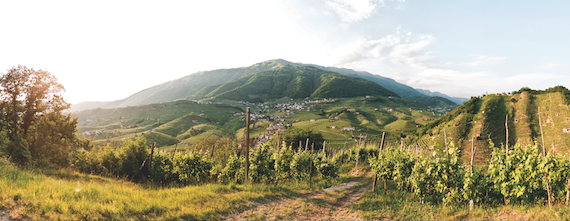With international distribution of DOCG wines relatively fixed and no plans to extend production (for reasons of geography, not to mention geology), the strategy is to build value. “In the past 20 years we did grow volume but, since 2009, everything has changed and we have been growing value instead,” says Vettorello. “Now we are not looking to expand but we are looking for markets that will pay more. Last year we grew value 10% in the UK.”
Understanding the product
Matteo Bisol of the Bisol winery, which is known for its DOCG wines, says that for differentiation the word ‘superiore’ is important in convincing consumers to understand the product – and pay more for it. “It’s difficult to be a quality prosecco producer because we have to convince people to spend more. It’s a big challenge but we think prosecco can reach a higher quality level. There are very good proseccos at £15-£20.”
If prices head north, prosecco DOCG wines will brush shoulders with champagne brands that seem to be headed the other way. “Bisol Crede is at a similar level to champagne but it’s much better to drink an expensive prosecco than a cheap champagne,” says Bisol.
Prosecco is a very different wine to champagne but in the DOCG, where there is increased acidity, dryness and sometimes mineral character, it is as close as it can be to champagne. Brands such as Bisol, Follador and Ruggieri have spearheaded this style.
“This dry crispness and small, soft bubbles can appeal to champagne drinkers” says Bisol, but adds that “there are sparkling wines for different moments, just as there are among other wine styles”.
Despite the need for more proseccos to compete in the same price bracket as champagne, many producers are wary of the comparison. “Prosecco and champagne are totally different products that cannot be compared,” says Irene Patruno of Bottega. “Prosecco is made from Glera and possibly a few other indigenous grapes (max 15%), while champagne is made from Pinot Noir, Pinot Meunier and Chardonnay.
“Different soils, different climate conditions and, above all, different production processes: Charmat-Martinotti method versus Méthode Champenois. Although they both are usually associated with the idea of celebration, they have very little in common.”
Looking ahead
According to Zonin, which is known for its vast DOC production, DOCG is starting to gain traction “where prosecco is already a large category – in the US, UK, Benelux and Nordic countries”, says Massimo Tuzzi. He warns, though, that consumers must be established DOC drinkers before they can make the step.
Last year Zonin introduced its first DOCG prosecco. “1821 was launched at TFWA Cannes 2013,” says Tuzzi. “We are market leaders in sparkling wine and we needed to have a super-premium prosecco in our portfolio. We had 17m bottles but no prosecco DOCG.”
Follador, like Bisol, is a forerunner of the high-end marketing of prosecco. Cristina Follador pinpoints the UK, northern Europe and North America as “ripe for development” as they are established DOC markets. To stand out from the DOC crowd though, there is “the need for positive marketing” to “develop a premium brand in the international marketplace”. Follador is hoping to push its credentials in the premium platform of travel retail. It is currently the only Valdobbiadene Superiore exhibiting at the TFWA.




